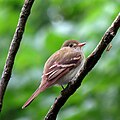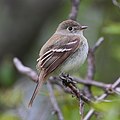| Empidonax | |
|---|---|
 | |
| Alder flycatchers, Empidonax alnorum | |
| Scientific classification | |
| Kingdom: | Animalia |
| Phylum: | Chordata |
| Class: | Aves |
| Order: | Passeriformes |
| Family: | Tyrannidae |
| Genus: | Empidonax Cabanis, 1855 |
| Type species | |
| Empidonax pusillus Cabanis, 1855= Platyrhynchos virescens Vieillot, 1818 | |
| Species | |
See text | |
The genus Empidonax is a group of small insect-eating passerine birds in the tyrant flycatcher family, the Tyrannidae that are found in North and South America.














